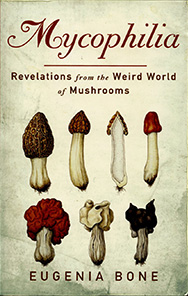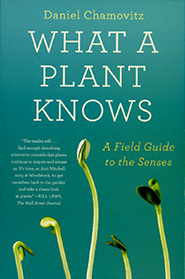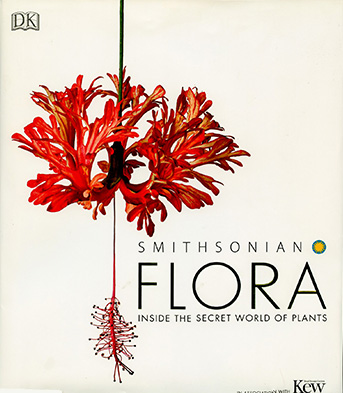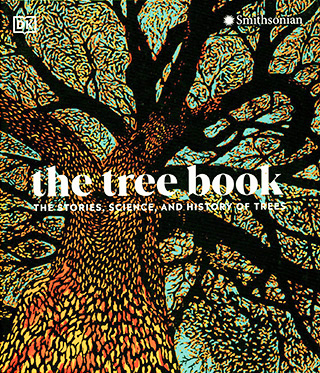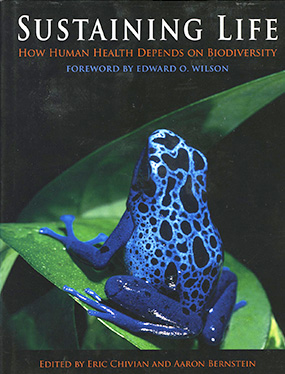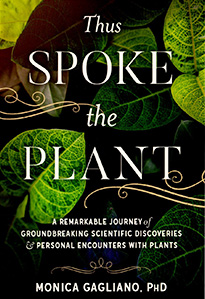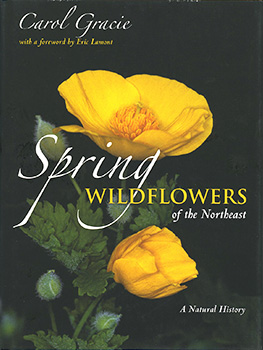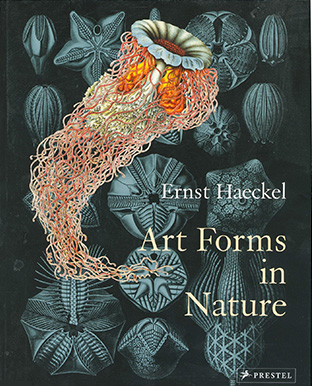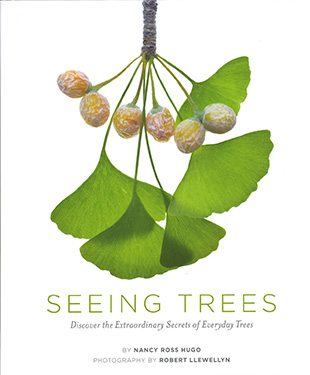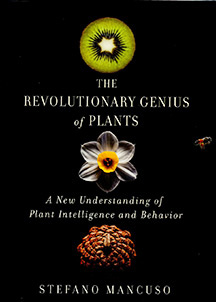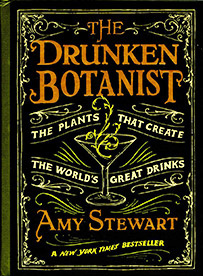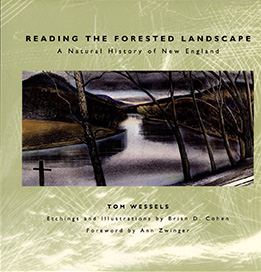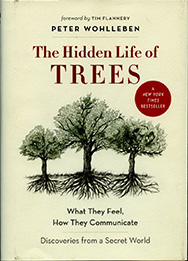
A Deeper Look Bibliography

|
|
This section lists books that are not field guides, but that explore some deeper aspect of botany. Note: book cover sizes in the list below are shown relative to each other. The list is organized by primary author. Some out-of-copyright books are available free at the supplied links. |
|
Mycophilia: Revelations from the Weird World of Mushrooms Author(s): Bone, Eugenia Publisher: Rodale Books, 2011 ISBN: 978-1609619879 Comments: I really enjoyed this book. The author relates her developing infatuation with mycology, the study of fungi. I think she coined the term “mycophilia.” Her writiing is lucid, funny, ireepressibly enthusiastic, and not overly technical. 368 pages. |
|
|
What a Plant Knows: A Field Guide to the Senses Author(s): Chamovitz, Daniel Publisher: Scientific American, 2012 ISBN: 978-0374537128 Comments: How do plants figure out how to go about their business, without brains or nervous systems? How does a mimosa know to snap shut on an insect? How do plants know which way is up? How do they sense things in their environment? How do they attract pollinators, or repel insects, animals, or competing plants? The author considers these and similar questions in tnis scientific but highly readable book. 177 pages. |
|
|
The Species Seekers: Heroes, Fools, and the Mad Pursuit of Life on Earth Author(s): Conniff, Richard Publisher: W. W. Norton and Company, 2011 ISBN: 978-0393341324 View at: Barnes & Noble, or Amazon Comments: In the mid-1700s Carl Linnaeus came up with a system for indentifying living things based on properties they had in common. This was the first serious attempt to classify nature's nearly limitless variety, and it kicked off a European and later worldwide infatuation with finding and naming living things. In Richard Connif's hands, this is not a dry story of academic accomplishment, but a swashbuckling account of personalities, intrigues, egos, hostile environments, immense sacrifices, and incredible achievements. I couldn't put it down. |
|
|
Flora: Inside the Secret World of Plants Author(s): DK Publisher: DK, 2018 ISBN: 978-1465474506 Comments: This stunning coffee table book is a superb introduction to botany. With contributions from Kew The Royal Botanic Gardens, and the Smithsonian Institution, the science is superb. The large format pages display exquisite detail, and the descriptions are imaginative and informative. Although targeted at adult readers, this is a book that children will enjoy too. 440 pages. |
|
|
The Tree Book: The Stories, Science, and History of Trees Author(s): DK Publisher: DK, 2022 ISBN: 978-0744027464 Comments: This is a gorgeous coffee table book on trees—their natural history, identification, cultural importance, anatomy, and beauty. 352 pages. This 4 pound large format book probably won’t fit in your back pocket. |
|
|
Wildflowers of the Eastern United States Author(s): Eastman, John Publisher: Stackpole Books, 2014 ISBN: 978-0811713672 View at: Barnes & Noble, or Amazon Comments: This isn't so much an identification guide as a deeper look into some of the commonest wildflowers of the eastern US. When John Eastman looks at a wildflower, he perceives it as part of the interlocking ecological web in which it is enmeshed. Its relatives, its enemies, the animals and insects that feed on it. Where it thrives, how it reproduces, how it is pollinated, herbal lore. This, along with Eastman's other books, left me with a more deeply nuanced understanding of the balance of nature. 130 species, with nice photos. 282 pages. |
Eastern United States |
|
The Book of Swamp and Bog: Trees, Shrubs, and Wildflowers of Eastern Freshwater Wetlands Author(s): Eastman, John; illustrated by Hansen, Amelia Publisher: Stackpole Books, 1995 ISBN: 978-0811725187 View at: Barnes & Noble, or Amazon Comments: Describes "trees, shrubs, and wildflowers of eastern freshwater wetlands." This book, and others in the series, is not a guide in the traditional sense. It describes a relatively small number of common species in their full ecological context, providing deeper insight into the world that surrounds each plant. The author lists birds and other associated animals; insects that feed on (or in some cases are digested by) the plants; pollinators and gall-producing insects; and fungal threats. Descriptions are rich with detail, but not overly technical. 237 pages. |
Eastern North America |
|
The Book of Field and Roadside: Open-Country Weeds, Trees, and Wildflowers of Eastern North America Author(s): Eastman, John; illustrated by Hansen, Amelia Publisher: Stackpole Books, 2003 ISBN: 978-0811726252 View at: Barnes & Noble, or Amazon Comments: I love these books! (See also The Book of Swamp and Bog and The Book of Forest and Thicket.) Learning to identify a plant is one matter, a pleasant challenge to be sure, but one that leaves us with only the most superficial of introductions. What if you could be fully immersed in the world of the plant? Eastman’s books describe a relatively small number of common species in rich but not overly technical detail. I feel like a tiny bee might, as I see the insects that frequent the plant, the fungal blights it must tolerate, the birds who favor its fruits, its friends and associates. Amelia Hansen's detailed line drawings focus sometimes on the plant itself, but often on some aspect of the plant's environment. These books aren't really field guides, but they are much more. 336 pages. |
Eastern North America. |
|
The Book of Forest and Thicket: Trees, Shrubs, and Wildflowers of Eastern North America Author(s): Eastman, John; illustrated by Hansen, Amelia Publisher: Stackpole Books, 1992 ISBN: 978-0811730464 View at: Barnes & Noble, or Amazon Comments: I love these books! (See also The Book of Swamp and Bog and The Book of Field and Roadside.) Learning to identify a plant is one matter, a pleasant challenge to be sure, but one that leaves us with only the most superficial of introductions. What if you could be fully immersed in the world of the plant? Eastman's books describe a relatively small number of common species in rich but not overly technical detail. I feel like a tiny bee might, as I see the insects that frequent the plant, the fungal blights it must tolerate, the birds who favor its fruits, its friends and associates. Amelia Hansen's detailed line drawings focus sometimes on the plant itself, but often on some aspect of the plant's environment. These books aren't really field guides, but they are much more. 212 pages. |
Eastern North America |
|
Sustaining Life: How Human Health Depends on Biodiversity Author(s): Edited by Chivian, Eric and Bernstein, Aaron Publisher: Oxford University Press, 2008 ISBN: 978-0195175097 View at: Barnes & Noble, or Amazon Comments: This beautiful volume is not a field guide. It is the result of a large scale international effort, initiated in 1992, to coordinate "what was known about how other species contribute to human health." The project was directed by Nobel Peace Prize-winning scientist Eric Chivian, and consolidates information from over 100 contributors. It demonstrates in myriad ways that biodiversity is essential to human existence. 542 pages. |
|
|
Author(s): Gagliano, Monica Publisher: North Atlantic Books Comments: The author makes an interesting and engaging case for plants as being far more sophisticated in their sensory and reasoning capacity than we generally assume. She suggests that plants have a kind of consciousness. I very much enjoyed her well-written book, but I was not convinced of the premises. 176 pages. |
|
|
Spring Wildflowers of the Northeast: A Natural History Author(s): Gracie, Carol Publisher: Princeton University Press, 2012 ISBN: 978-0691144665 View at: Barnes & Noble, or Amazon Comments: This is a collection of essays about some common wildflowers from the northeastern United States. Carol Gracie’s stories provide a much deeper understanding of the role each plant plays in its enviornment, and 500 detailed photos capture the beauty and uniqueness of these flowers. This is not a field guide, it is a book about natural history. Another of Gracie's books, which she co-authored with Steven Clemants, is Wildflowers in the Field and Forest, among my favorites. 272 pages. |
Northeastern United States. |
|
Author(s): Haeckel, Ernst Publisher: Prestel, 1862 ISBN: 978-3791319902 Comments: Ernst Haeckel’s eye for the infinite variety, beauty, and symmetry of nature is evident in these incredible plates, originally released in 1862. The artist combines the rigor of a scientist and the eye of an artist in these captivating images of living things. Subjects are identfied. 139 pages. |
|
|
Author(s): Haskell, David George Publisher: Penguin Books, 2013 ISBN: 978-0143122944 View at: Barnes & Noble, or Amazon Comments: An amazing book! What would happen if you drew a circle about a meter in diameter at an arbitrary spot in the woods, then visited the same spot nearly every day for a year? Plenty, at least if you train yourself to play close attention to more of what is going on. David Haskell writes with a deep understanding of ecology; familiarity with a wide range of plant, animal, fungal, and microscopic life; and the soul of a poet. The book is organized as a series of short, rich essays prompted by different visits. I recommend this book for anyone who wants to understand the forest’s intriciate web of living relationships on a deeper level. The book is easy to read, not laden with dense terminology. Oh, and you'll find out what a mandala is. |
|
|
Author(s): Hugo, Nancy Ross; Photographed by Llewellyn, Robert Publisher: Timber Press, 2013 ISBN: 978-1604692198 View at: Barnes & Noble, or Amazon Comments: Seeing Trees is not a field guide, though it will most certainly improve your ability to identify trees in the wild. It falls somewhere between coffee table book, with its large format, nontechnical presentation, and arresting photography; and enthusiast's guide to the world of trees. Roughly the first half of the book is a series of discussions about traits of trees. The rest is dedicated to a much deeper discussion of only ten species of trees, with the goal of understanding how they function, reproduce, and interact with their environment. This is a book that deepens our perspective of the natural world. 242 pages. |
|
|
Author(s): Kennedy, David O. Publisher: Oxford University Press, 2014 ISBN: 978-0199914012 Comments: This is an amazing book, a scholarly masterpiece. Kennedy sifts through a huge volume of data on the biochemicals created by plants that influence the operation of our brains. He covers a wide spectrum of drugs, including hallucinogens, cannabs, nicotine, opioids, and caffeine. The writing is dense and quite technical, but lucid. It helps to have a backgroud in biology and neuroology, but it isn't mandatory. 379 pages. |
|
|
The Revolutionary Genius of Plants: A New Understanding of Plant Intelligence and Behavior Author(s): Mancuso, Stefano Publisher: Atria Books, 2017 ISBN: 978-1501187858 View at: Barnes & Noble, or Amazon Comments: This is a great read. Stefano Mancusso compares various aspects of plant and animal survival strategies, showing the many clever ways in which plants adapt and compete. He challenges our assumptions about whether it is plants or animals that are the higher form of life. Plants are much more interesting and innovative than we tend to realize. I learned a lot and enjoyed the author’s enthusiasm and style. 240 pages. |
|
|
Author(s): Pollan, Michael Publisher: Penquin Press, New York, 2021 ISBN: 978-0593243787 View at: Barnes & Noble, or Amazon Comments: Micahel Pollan has written many thought-provoking and highly readable books about botanical subjects. From the book’s summary: “... Pollan dives deep into three plant drugs—opium, caffeine, and mescaline—and throws the fundamental strangeness and arbitrariness of our thinking about them into sharp relief.” He examines the cultural implications of these drugs, interwoven through human history. |
|
|
Author(s): Stewart, Amy Publisher: Algonquin Books, 2013 ISBN: 978-1616200466 Comments: When you actually know about the botanical cornucopia of ingredients that go into mixed drinks, you have a whole new appreciation of plants. And a sense that we have just scratched the surface, exploring the potential of plants for medicine, food value, structural materials, or simply a bit of indulgence. This book contains recipes and a look at their botanical background. 400 pages. |
|
|
Bringing Nature Home: How You Can Sustain Wildlife with Native Plants Author(s): Tallamy, Douglas W. Publisher: Timber Press, 2020 ISBN: 978-0881929928 Comments: Douglas Tallamy describes the complex ways in which native species of plants interact with their surroundings and other animals and insects to create a healthy, vibrant habitat. By contrast, landscaping that uses non-native species impedes this balance severely. He makes a clear, non-technical case for gradually replacing non-native plantings with native counterparts. Extensive photographs show representative species and their interactions. 358 pages. |
|
|
Author(s): Wessels, Tom Publisher: The Countrymen Press, 2010 ISBN: 978-0881509182 View at: Barnes & Noble, or Amazon Comments: Described as a "field guide to reading the forested landscape," this is not a guide to identifying plants, but rather a guide to determining the uses to which land has been placed in past. Based on clues such as land shape, type and distribution of rocks, stumps and growth patterns of trees, Wessels is able to infer how land was previously used. 160 pages. |
|
|
Reading the Forested Landscape: A Natural History of New England Author(s): Wessels, Tom; Cohen, Brian D. Publisher: Countryman Press, 2005 ISBN: 978-0881504200 Comments: I found this book fascinating. With some practice—okay, probably a lot of practice—you can view a wooded landscape or a field and figure out a lot about its history. Was it once a farm? Did it host livestock? Was it logged? What kind of weather did it experience, and when? By examining everything from placement of stones, to random-seeming bumps of land, to scars on trees or remains of downed trees, you can ascertain a great deal of information about a land parcel. Cleverly composed drawings illustrate the book. 200 pages. |
|
|
The Hidden Life of Trees: What They Feel, How They Communicate—Discoveries from a Secret World Author(s): Wohlleben, Peter Publisher: Greystone Books, 2016 ISBN: 978-1771642484 Comments: Peter Wohlleben presents trees and the ecosystems they create in a much deeper and more nuanced way. Using surprising means of communication, trees exist in cooperative groups reminiscent of animal social groups, interacting, protecting, and nurturing. You won’t think about trees the same way after you finish this resdable, nontechnical book. 288 pages. |
